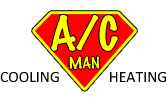8 Important Parts Of HVAC System In Houston
HVAC, which is the acronym for heating, ventilation, and air-conditioning describes a system that cools and heats your home. Over the months of winter, you will rely on the furnace in the HVAC system, and in summer the AC side of the system is used to keep your home comfortable and cool.
While some of the homes are cooled and heated with the window or mini-splits air-conditioners, heat pumps, radiant floor heating, or boilers, today we are here to tell you about the 8 parts that make up a home HVAC system, which contains the traditional split-system air-conditioner and furnace combination.
 1. Thermostat
1. Thermostat
This is the most important part of an HVAC system, and the thermostat really deserves to be mentioned first. This thermostat has a connection that is direct to the cooling and heating components, which allows this device to control when the furnace or AC turns on.
Today, there are a variety of thermostats available, which includes the programmable models. These models automatically alter the temperature according to the schedule you have set. You also have the choice to have multiple thermostats installed for the purpose of zoning.
2. The Blower Motor & Furnace
The blower motor and furnace are 2 main parts in an HVAC system. The furnace is usually large and will require a dedicated area in a closet, attic, or basement.
The fuel source which is either electricity, oil, or natural gas will heat the incoming air. The blower motor will distribute the air that is now heated through the ductwork, which then flows out of the supply registers. Cool air is then pulled back in through the return registers, where the process starts again. This blower motor will often perform the task of an air-distribution source when it comes to the air-conditioner.
3. Heat Exchanger
All furnaces feature heat exchangers, that activate as soon as the thermostat requires heat. If your furnace is running on oil or gas, the burners are what accomplish heating. If your fuel source is electricity, then the electric coils will provide heat into the air.
When the air in the heat-exchanger starts warming up, the heat will transfer to the walls made of metal. The blower performs the task of sucking air inside the furnace, and then the air is circulated over the heat exchanger’s exterior walls. The air is heated up rapidly before it is circulated back into a room through supply registers.
The heat exchanger needs to stay sealed, especially when the furnace is using oil or natural gas, which will fill up the heat-exchanger with fumes that are combustible, which will include CO (carbon monoxide) which is poisonous. Under standard conditions, the vent will send fumes that have cooled down outside the furnace which is then harmlessly dispersed into the surrounding air. However, if there are cracks present in your heat exchanger, then the fumes could escape into your home, which could put the inhabitants in your home at risk. This is why it is important to have your HVAC system serviced regularly to avoid these issues.
4. Evaporator Coil
The evaporator coil makes up the inside part of the split-system air conditioners. It is typically housed inside an enclosure made out of metal on the top or side of your furnace. Refrigerant will flow through this coil, which looks similar to the radiator in a car. It performs the role of absorbing the heat that comes from indoor air that passes over it. Once the heat is removed, the cooled air can then circulate and flow back into your home.
5. Condensing Unit
When you consider all the parts in a home HVAC system that hold the responsibility of cooling, this component is usually the first one you will think of. This is a type of metal unit which is installed outside of your home that expels the heat that is absorbed from the indoor air outside. This process also gets the refrigerant ready for the next round where it once again flows over the evaporator coils. It absorbs the heat again and cools the home even further.
6. Refrigerant Lines
An air conditioner is unable to operate without refrigerant. Refrigerant lines in an HVAC system are made up of aluminum or copper and these lines run from the condensing unit (outside) to the evaporator coil (inside).
7. Ductwork
Forced-air cooling and heating will also rely on the presence of ductwork in order to evenly distribute the conditioned air into your home. It is also easier to have ductwork installed during the phases of construction, although retrofits are also sometimes a possibility. When possible, the ducts should not run through crawl spaces, your garage or attic. In the cases, where this cannot be avoided, the ducts need to be insulated and sealed to stop the ducts from being exposed to drastic temperature changes between living spaces and these areas.
8. Supply & Return Registers
These are covers that are installed over the openings of the ductwork. They are usually rectangular and situated in the walls, floors, or ceiling, which will depend on the overall layout of the ductwork. The registers usually feature louvers that you are able to close and open in order to control the airflow. You should aim to keep a minimum of 80% of these supply registers in an open position to stop the system from becoming unbalanced. It is also important to ensure curtains and furniture are not blocking the supply and return registers throughout the home.
We hope this information has helped you to understand more about the 8 basic parts that make up your home HVAC system.
We are the top service provider for AC services in Houston, air-conditioning repairs in Katy TX, and the rest of the Greater Houston areas. We are aware that there are many options available when choosing a Cooling & Heating contractor in your area for your business or home. Yet this is where AC Man excels, as we are highly focused on customer satisfaction.
AC Man specializes in repairing all the major brands when it comes to HVAC units. Our technicians are all professional, friendly, and courteous. These knowledgeable technicians are here to offer you with top-rated service options. We will also provide you with an honest and upfront quote for the costs involved for your repairs before any work commences. In the middle of summer, you need an air-conditioning system that is efficient and is functioning well. Avoid having to endure the heat because your AC system has become faulty.
For the best AC repair services around, call or contact AC Man of Houston and our experts are waiting to assist you with any AC replacement, repair, and maintenance service. We are experienced in serving all types of makes and models of AC systems. You can rely on our services for all your AC needs (except window units).
